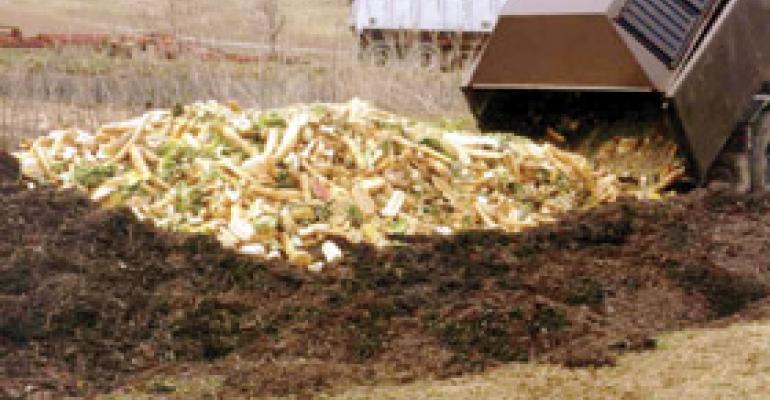A few months ago, two Albertsons stores in Santa Barbara, Calif., accomplished something exciting for the food retailing industry, becoming the first supermarkets in the nation to achieve “Zero Waste” classification. More than 95% of all waste generated by the stores is now either recycled, reused or composted, thus diverting more than 2 million pounds of waste from landfills annually, including 808,000 pounds of cardboard, 27,500 pounds of plastic and almost 2,700 pounds of paper.

Of course, this didn't happen overnight. Supervalu's Southern California Division, which operates the stores, has been working on an aggressive recycling campaign for more than three years, and during that time, the entire division has reduced its waste by 55%, according to Rick Crandall, the division's director of environmental stewardship.
“To get to this stage, we did what we call Dumpster dives — or ‘waste chain audits,’ which sounds a little more politically correct,” Crandall said. Fifty-five separate times, Crandall and his team went to stores, emptied the Dumpsters or compactors, separated all the trash into 35 different categories, and weighed all of it. Because, as Crandall explained, “If you don't know what's in there, how are you going to get rid of it?”
Once the region's recycling efforts were intensified, Crandall found that the next largest factor in its waste stream was edible food — bruised produce or meat that had reached its sell-by date, for example. A program called “Fresh Rescue” was launched, and the region's stores are now working with almost 100 local food banks to donate non-spoiled perishables to soup kitchens, missions and other non-profit programs that give food to those in need.
After these programs were implemented, the two Albertsons locations took everything one step further, partnering with the city of Santa Barbara on a new composting program geared toward reducing the city's landfill use. Anything that wouldn't be donated — fat and meat renderings, spoiled food, expired seafood, produce trim and the like — could now be disposed of as well, allowing the two locations to achieve the zero waste classification.
Whether the goal is reducing environmental impact, complying with new local or state regulations, or simply finding new ways to cut costs, the biggest challenge is often finding the right partners or facilities that can help a supermarket divert waste into channels that are more productive than landfills.
For example, it is very difficult to recycle the wax-treated cardboard boxes commonly used to transport products that have been hydrocooled or packed in ice. Supervalu's Southern California Division, however, now annually gives about 2.5 million pounds of these boxes to CleanFlame, a company that turns the cardboard into starter logs for campfires and fireplaces.
Similarly, a growing number of supermarkets are now diverting organic waste to local composting facilities. But, unless a retailer wants to get in the business of making and selling compost themselves, it will difficult to get one of these programs off the ground if there are no industrial composting facilities within a reasonable distance of a company's distribution centers.
“There is, what we call, an infrastructure gap between a number of companies that would like to be separating their organic waste and the facilities that could handle it, and between the haulers that connect them,” said Cary Oshins, education program manager for the U.S. Composting Council. “The industry is growing, but [growth and infrastructure] varies regionally.”
In an effort to help large-scale buyers and sellers connect, the council's website, compostingcouncil.org, offers visitors a map of member facilities nationwide, searchable by ZIP code.
Due to logistical challenges like these, Stater Bros. Markets Chairman and Chief Executive Officer Jack H. Brown said that he expressed some reservations when his company's “Green Team” initially proposed a companywide composting program.
“Boy was I wrong,” he laughed. “It's been a real outstanding program for us.”
On Earth Day in April 2009, Stater Bros. locations began putting organic waste such as produce trim and cull, paper and certain types of cardboard and wooden crates into containers specially designed to prevent contamination. These containers are backhauled to the company's distribution center before being sent to composting facilities. Ultimately, the waste from Stater Bros. is converted into fertilizers for farms in California's Central Valley.
By the end of 2009, the 167-unit chain had diverted 27 million pounds of organic waste from landfills. Last year, Stater Bros. diverted 39 million pounds of waste, and was recognized with a Waste Reduction Awards Program “Green Business Practices” award by the state of California.
Brown said that the company was fortunate — its average haul is only 40 miles. And overall, the program is cost-neutral, which ultimately made it an easier decision to stick with the environmentally friendly option.
“We don't just do business in our community, we are part of it,” he said. “And to develop a composting program for organic materials — it's part of our commitment to being part of the community. If it's good for the community, it's good for Stater.”
At Supervalu, Crandall is already thinking ahead to get other stores closer to zero waste. Composting has lots of benefits, he noted, but there are some drawbacks as well. Facilities are generally located in rural areas, so lots of energy can be used in transport. Also, facilities can give off methane — a greenhouse gas.
“For the last bit of waste in [our] waste stream, I'm looking at three major ways of getting rid of it, and we're testing all three,” he said.
One is compost, he said. Another is waste-to-energy, in which anaerobic digesters convert organic materials into green energy. A third is waste-to-feed, where food waste is sorted and turned into animal feed.





